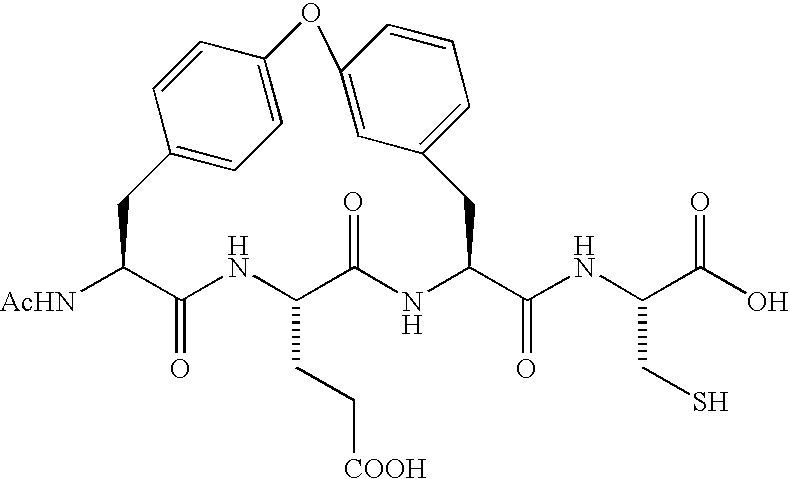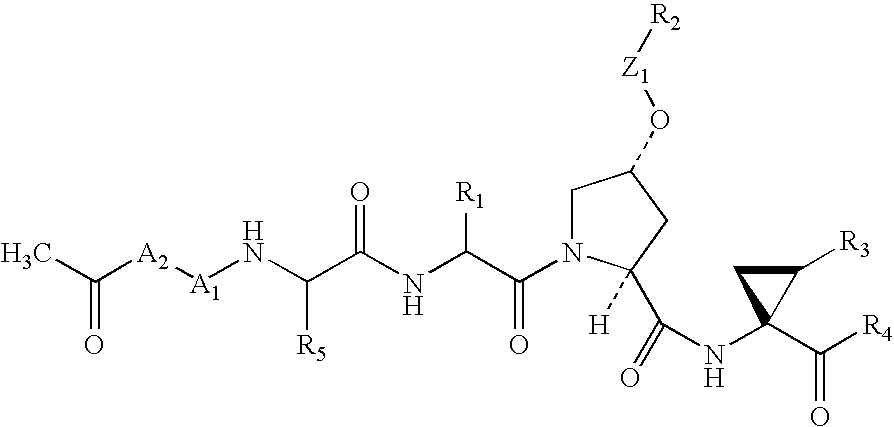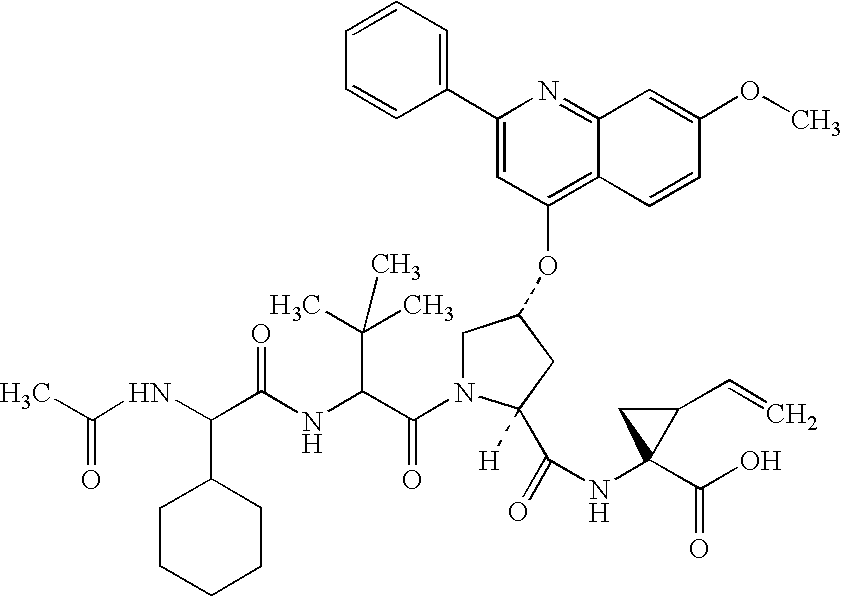Novel peptides as NS3-serine protease inhibitors of hepatitis C virus
a peptide and hepatitis c virus technology, applied in the field of hcv protease inhibitors, can solve the problems of low sustained response rate of therapies, frequent side effects, poor treatment effect of patients with hcv infection,
- Summary
- Abstract
- Description
- Claims
- Application Information
AI Technical Summary
Benefits of technology
Problems solved by technology
Method used
Image
Examples
example 1
PREPARATIVE EXAMPLE 1
[0137]
[0138] To a stirred solution of compound (1.08)(3.00 g, 12.0 mmol; Harbeson, S. L.; Abelleira, S. M.; Akiyama, A.; Barrett, R.; Carroll, R. M.; et al.; J. Med. Chem.; 37 (18) 1994; 2918-2929;) in DMF (15 mL) and CH2Cl2 (15 mL) at −20° C. was added HOOBt (1.97 g, 12.0 mmol), N-methyl morpholine (4.0 mL, 36.0 mmol) and EDCI (2.79 g, 14.5 mmol) and stirred for 10 minutes, followed by addition of HCl.H2N-Gly-OBn (2.56 g, 13.0 mmol). The resulting solution was stirred at −20° C. for 2 hrs, kept refrigerated overnight and then concentrated to dryness, followed by dilution with EtOAc (150 mL). The EtOAc solution was then washed twice with saturated NaHCO3, H2O, 5% H3PO4, brine, dried over Na2SO4, filtered and concentrated to dryness to give the Compound (1.09) (4.5 g, 94%). LRMS m / z MH+=395.1.
[0139] A solution of compound (1.09) (7.00 g, 17.8 mmol) in absolute ethanol (300 mL) was stirred at room temperature under a hydrogen atmosphere in the presence of Pd—C (...
example 2
PREPARATIVE EXAMPLE 2
[0140]
[0141] A mixture of Compound (1.1) from Preparative Example 1, Step B (1 eq.), Compound (1.2) (Novabiochem, No. 04-12-5147) (1.03 eq.), HOOBt (1.03 eq.), N-methylmorpholine (2.2 eq.), and dimethylformamide (70 mL / g) was stirred at −20° C. EDCI (1.04 eq.) was added and the reaction stirred for 48 hr. The reaction mixture was poured into 5% aqueous KH2PO4 and extracted with ethyl acetate (2×). The combined organics were washed with cold 5% aqueous K2CO3, then 5% aqueous KH2PO4, then brine, and the organic layer was dried over anhydrous MgSO4. The mixture was filtered, then evaporated and the filtrate dried under vacuum, the residue was triturated with Et2O-hexane, and filtered to obtain the title compound (1.3)(86% yield), C25H39N3O7 (493.60), mass spec. (FAB) M+1=494.3.
[0142] Compound (1.3) from Preparative Example 2, Step A (3.0 g) was treated with 4 N HCl / dioxane (36 mL) and stirred at room temperature for 7 min. The mixture was poured into 1.5 L cold (...
example 3
PREPARATIVE EXAMPLE 3
[0143]
[0144] Compound (1.3) from Preparative Example 2, Step A, was treated in essentially the same manner as in Preparative Example 7, Step A below to afford Compound (1.5).
PUM
| Property | Measurement | Unit |
|---|---|---|
| temperature | aaaaa | aaaaa |
| volume | aaaaa | aaaaa |
| pH | aaaaa | aaaaa |
Abstract
Description
Claims
Application Information
 Login to View More
Login to View More - R&D
- Intellectual Property
- Life Sciences
- Materials
- Tech Scout
- Unparalleled Data Quality
- Higher Quality Content
- 60% Fewer Hallucinations
Browse by: Latest US Patents, China's latest patents, Technical Efficacy Thesaurus, Application Domain, Technology Topic, Popular Technical Reports.
© 2025 PatSnap. All rights reserved.Legal|Privacy policy|Modern Slavery Act Transparency Statement|Sitemap|About US| Contact US: help@patsnap.com



